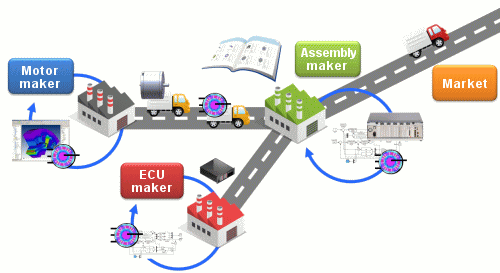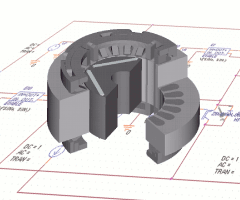Motor Drive System
New motor drive design methodology is required to meet the increasing demands placed on electromechanical machines. Model-based development facilitates a collaborative design approach between machine and control designers. “JMAG-RT” is capable of completing the bridging the gap between these two development teams. JMAG RT creates a block for control development based on the machine characteristics determined by the motor designers.
- Motor drive system design and optimization that imports real motor properties
- Reducing setbacks and improving efficiency in motor drive system development
- Control algorithm verification with MILS
- Behavior verification of DSP and ECU using HILS, defect countermeasures
V-model development cycle
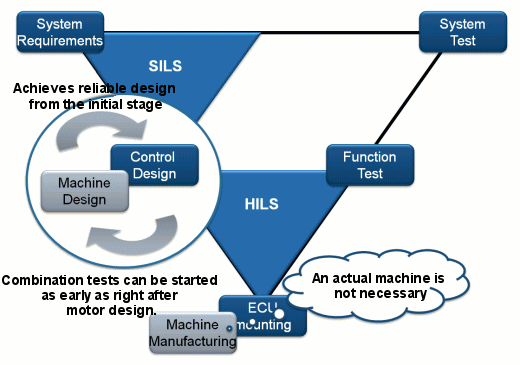
Using JMAG-RT motor models in SIL/HIL enables you to perform reliable design from the initial stage.
Also, combination tests can be run right after motor design without the actual machine.
JMAG-RT is a model created from FEA results. The same model can be shared between departments such as motor design, circuit design, and control design.
JMAG-RT in SILS/MILS
A 3D motor model in the motor design department will be succeeded as a 1D plant model to the control simulator in JMAG-RT.
Detailed motor characteristics obtained by JMAG can be simulated on the control simulator at the same speed as when an ideal motor is used.
Case Study: The invertor’s IGBT is broken down while driving
Timing is vital when detecting breakdowns, making it crucial for verification to gain an accurate grasp of torque variations. This case shows the U-phase upper arm is short-circuited in 0.05 sec. Also enables confirmation of a phenomenon where unbalanced current is flowing through each of the three phases.
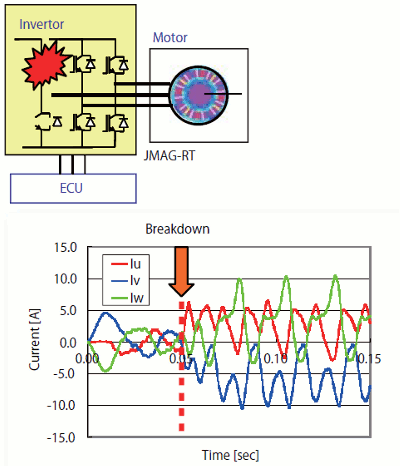
Supported System Level Simulator
| Company Name | Product | Country |
|---|---|---|
| ESI ITI GmbH | SimulationX | Germany |
| Gamma Technologies | GT-SUITE | USA |
| MapleSoft | MapleSim | Canada |
| The MathWorks, Inc. | MATLAB/Simulink | USA |
| National Instruments | LabVIEW/VeriStand | USA |
| Powersim Inc. | PSIM | USA |
| Siemens Industry Software S.A.S. | LMS Imagine.Lab Amesim | Belgium |
| Synopsys, Inc. | SaberRD | USA |
| FunctionBay, Inc. | RecurDyn | Korea |
| POWERSYS/ AESIM.tech | SIMBA | USA |
| Smart Energy Laboratory Co.,Ltd. | Scideam | Japan |
JMAG-RT in HILS
HILS is becoming more important in model-based development because it makes studies of system operations and countermeasures for defects possible.
In HILS, conditions are created that are just like an actual motor is being driven from the controller’s standpoint, because motor models are calculated at actual speed with a real-time simulator.
However, HILS does not work effectively when the motor’s plant model being calculated by the real-time simulator displays different behavior from an actual motor, so system operations studies and defect countermeasures cannot be made.
JMAG-RT makes system operations studies and defect countermeasures possible using HILS in model-based development by employing real-time simulators on “JMAG-RT models,” or high-fidelity plant models.
Case Study: Verifying and testing a motor drive system ECU of hybrid vehicles
The control for optimizing the power balance between IC engines and traction motors is required for the ECU of hybrid vehicle motor drive systems. This case shows that when a motor model with low fidelity is used, torque is overestimated in low speed and underestimated in high speed. JMAG-RT enables to verify and test the ECU software precisely.
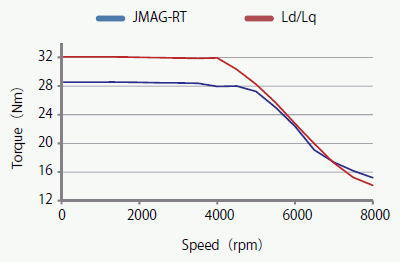
Supported Real Time Simulator
| Company Name | Product | Country |
|---|---|---|
| A&D COMPANY, LIMITED | HELIOS | Japan |
| Concurrent Real-Time Inc. | - | USA |
| DENSO TEN Limited. | CRAMAS | Japan |
| dSPACE GmbH | ASM | Germany |
| DSP Technology Co.,Ltd | RTSim | Japan |
| OPAL-RT Technologies Inc. | RT-LAB | Canada |
| Speedgoat GmbH | - | SWITZERLAND |
| Typhoon HIL | - | USA |
Making Motor Supply Chains More Efficient with JMAG-RT Models
JMAG-RT models do not contain motor information related to intellectual property, such as what kind of geometry the motor has or what grades of magnetic steel sheet or magnets are being used.
Also, the person who creates a JMAG-RT model can set whether to allow or disallow publication of information for each item.
This means it is possible to send and receive plant models between different companies while concealing important information.
As a result, it is no longer necessary to confirm product operations using spec sheets and actual machines as it has been in the past.
By putting JMAG-RT models on the market as spec sheets that allow operations studies, JMAG-RT can produce new supply chains and greatly accelerate the motor drive business.
